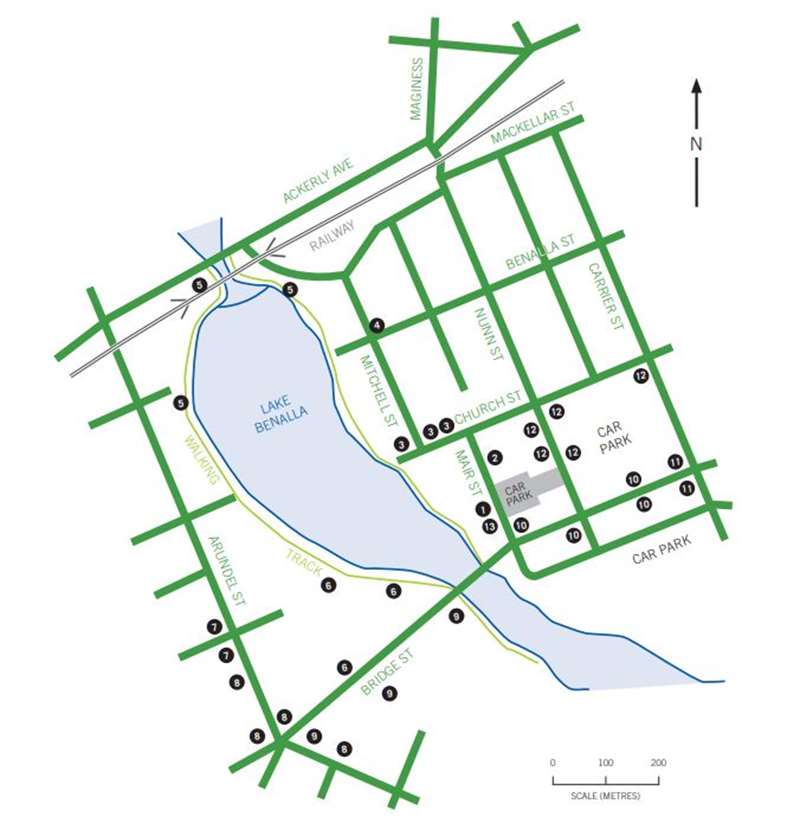Benalla Heritage Trail

From the site of the original Broken River Border Police Station, to the Barber Shop where Ned Kelly tried to escape custody, the Benalla Heritage Trail is packed with over 20 sites that bring to life the stories and histories of this beautiful rural city.
Discover for yourself with this self guided heritage tour around the Benalla.
Follow the blue plaques and other landmarks to experience highlights including historic buildings such as the courthouse and cell from the Kelly Gangs history and the Benalla Town hall, The Sir Edward 'Weary' Dunlop memorial, paths and walks around the Benalla Botanical Gardens and Lake Benalla, including the Bandstand (1911) and boulders bearing the stories of two events critical to the settlement of Benalla, Major Mitchell's crossing and the Faithfull massacre.
Discover layers of Benalla's history between the mid 1840s and early 1900s starting from town's earliest beginnings as the Broken River Border Police Station, to being a busy service town during the Ovens gold rush, to becoming a thriving rural township and centre in the early 1900s.
Pick up a brochure from the Visitor Information Centre or download the brochure.
Benalla Heritage Trail Map

Benalla Heritage Trail Notes
The development of Benalla can be clearly traced along a marked route in Benalla streets and by the Lake, featuring buildings, boulders and bridges, some of which bear a heritage blue plaque relating their significance.
1. The south wing of the Visitor Information Centre in the Museum complex was Benalla's first cultural centre: the Mechanics' Institute (1869). This was built near the site of Benalla's first European establishment, the Border Polic (1839).
2. From the Visitor Information Centre, turn left along Mair Street, the quaint 1870s home built by Robert Ledger and used for over 100 years by his family who were great contributors to the Benalla community.

3. The first Presbyterian church faces Mair Street, with the second, built in 1905, on the corner to your left.

A boulder marks the site of the first cemetery at the end of Church Street.

4. On the tree lined Mitchell Street, named for explorer Major Thomas Mitchell, is the imposing Victorian building that was the home of Benalla's first Shire President and MLA, George Sharpe.

5. By the Indigenous Garden, pass under the railway bridges, cross the low level bridge and take up the path near the rock wall built 1973 to form the Lake. Note the boulders bearing the stories of two events critical to the settlement of Benalla: Major Mitchell's crossing and the Faithfull Massacre.

6. Take the 'Dr Nicholson Path' through the Benalla Botanical Gardens, noting the 1911 bandstand, the cricket ground where several international teams have played, the Benalla Art Gallery (1975), two memorials to Benalla's "sons" Sir Edward Weary Dunlop and Captain Hec Waller and the rose gardens, the first section of which were planted 1959.

7. Take an alternative walk past the Bowling Club (est 1897) to Arundel Street, where the handsome Roman Catholic establishments of the school (1900) and the church (1909) are landmarks.

8. Next to the church, the first public (primary) school (1852) also bears a plaque, as do the two nearby hotels at the junction of Arundel and Bridge Streets.

As you cross to the 1860s Anglican Complex of Church, Parish Office and Parish Centre. The latter was formerly the Court House and is significant in the Kelly Gang story, as is the little shop opposite, formerly the bootmaker's shop.


9. Returning to Bridge Street, as you turn the corner the Drill Hall has a plaque as does the Showgrounds Grandstand.


Proceed to the Monash Bridge with a tollgate bearing its own story and a detailed history board on the CBD side.

10. The walk returns to the Visitor Information Centre, passing the Ceramic Mural, a Community project (1983-2010), or take the second loop walk along Bridge Street, where several blue plaques tell the story of the former post office, hotels (or their sites at the Reject Shop and Target) and banks which were clear indications of Benalla's growth in the 19th century.

11. The Carrier Street corner has plaques on opposing buildings. The Westpac Bank formerly operated as the Bank of NSW in a very handsome 1862 building and Millers Department Store has been operating since 1891, although with fewer departments than it once had.
12. Rounding the corner into Church Street, the Uniting church's plaque tells of its origin as the Methodist church. Pass the c1900 home of John Reilly (now a medical clinic), a partner in the Reilly Flour Mill on the next corner. A left turn takes you past the Memorial Hall, and to the two remaining 1880s buildings of the National Bank and Town Hall, though both with altered facades from their original.



13. Walking through the car park takes you back to the Visitor Information Centre and the Museum where you can see more items relating to Benalla's history, including the Kelly Saga (with an explanatory video and Ned's famous Green Sash), and the specialty costume exhibitions for which the Museum is renowned.

14. Further afield from this short walk, continue along Carrier Street to the Railway Station (1874) and The Victoria, The Farmers' Arms and The North East Hotels, all bearing their stories.



Photos:
Location
14 Mair Street, Benalla 3672 View Map
Web Links
→ Benalla Heritage Trail Brochure (PDF)








